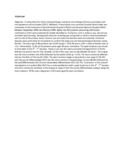| dc.contributor.author | Mutave, Regina | |
| dc.contributor.author | Dimba, Elizabeth | |
| dc.contributor.author | Wambeti, Njiru | |
| dc.contributor.author | Chindia, Mark | |
| dc.contributor.author | Muange, Penny | |
| dc.date.accessioned | 2015-03-24T07:41:26Z | |
| dc.date.available | 2015-03-24T07:41:26Z | |
| dc.date.issued | 2014 | |
| dc.identifier.citation | Muange, Penny, Mark Chindia, Wambeti Njiru, Elizabeth Dimba, and Regina Mutave. "Oral Squamous Cell Carcinoma: A 6-Month Clinico-Histopathologic Audit in a Kenyan Population." Open Journal of Stomatology 4, no. 10 (2014): 475. | en_US |
| dc.identifier.uri | http://file.scirp.org/Html/1-1460451_50828.htm | |
| dc.identifier.uri | http://hdl.handle.net/11295/81577 | |
| dc.description.abstract | Objective: To determine the clinico-histopathologic variations and etiological factors associated with oral squamous cell carcinoma (OSCC). Methods: A descriptive cross-sectional hospital based study was conducted at the University of Nairobi Dental Hospital (UNDH) and Kenyatta National Hospital (KNH) between September 2008 and February 2009. Eighty-two (82) patients presenting with lesions confirmed as OSCC were evaluated for habits identified as risk factors such as tobacco use, alcohol use and betel quid chewing. Demographic features including age and gender as well as clinical parameters such as site of the primary lesion, tumour size and nodal involvement were documented. Incisional biopsies were performed for all patients to confirm the diagnosis and histopathological features noted. Results: The mean age of the patients was 58.49 (range = 14 to 90 years), with a male to female ratio of 1.6:1. Remarkably, 13.4% of the patients were aged 40 years and below. The peak incidence was found to have been in the 6th - 7th decades. Tobacco use was the main associated etiological factor (73.2%) followed by alcohol use (57.3%). Notably, 25.6% of the cases had no identifiable risk factor. The tongue was the most common site (35%) followed by the palate (22%) (p = 0.03). The least commonly affected site was the floor of the mouth (10%). The most common stage at presentation was stage IV (52.4%) and; the poorly differentiated OSCC was the most common histopathologic variant (48.8%) followed by the well differentiated (30.5%) and moderately differentiated OSCC (20.7%). Conclusion: In the present investigation it is evident that OSCC has a male predilection with a peak incidence in the 6th - 7th decades and most commonly manifests in the tongue at stage IV with the poorly differentiated subtype being the most common. Of the cases diagnosed 13.4% were aged 40 years and below. | en_US |
| dc.language.iso | en | en_US |
| dc.title | Oral Squamous Cell Carcinoma: A 6-Month Clinico-Histopathologic Audit in a Kenyan Population | en_US |
| dc.type | Article | en_US |
| dc.type.material | en | en_US |

